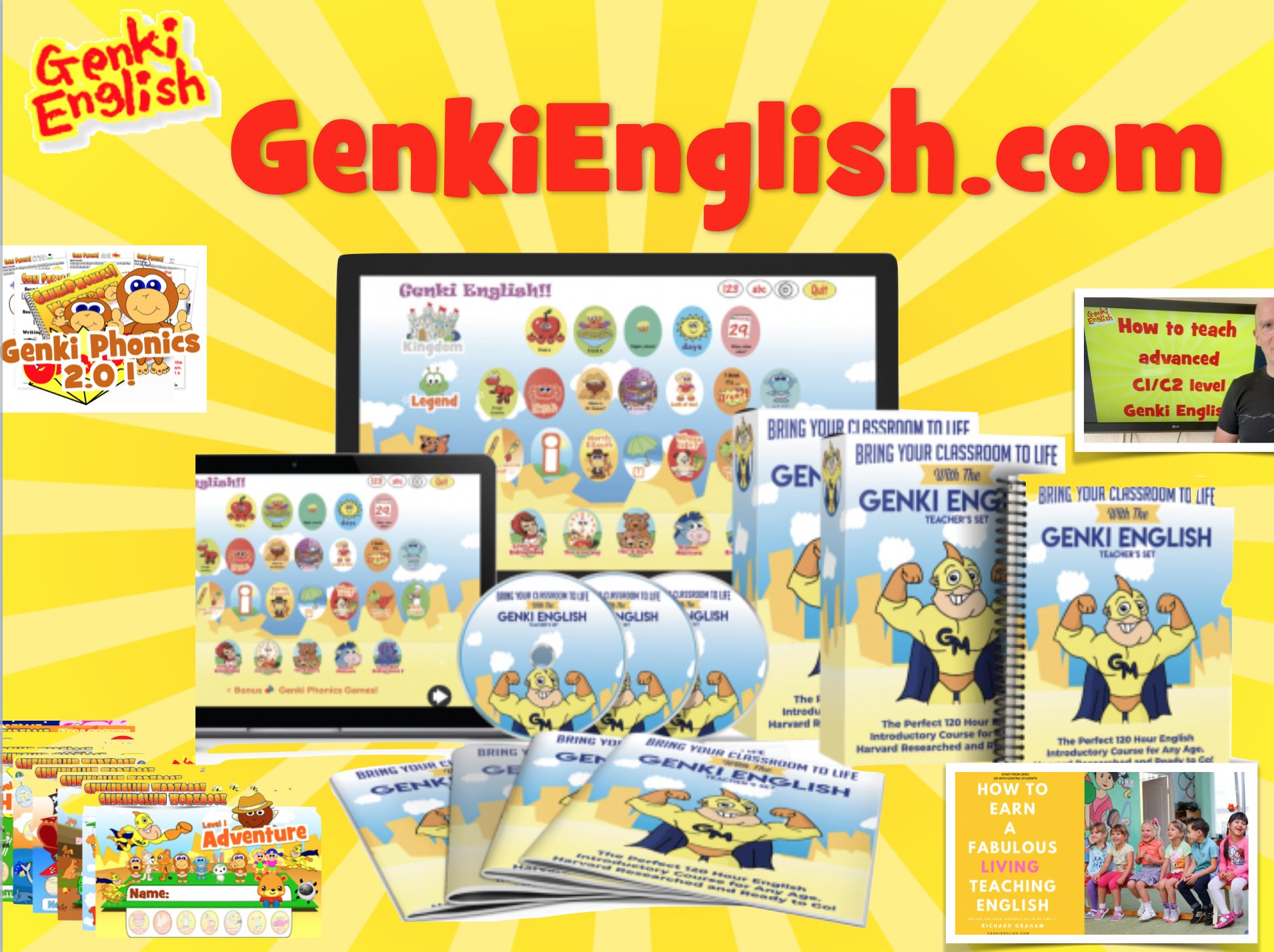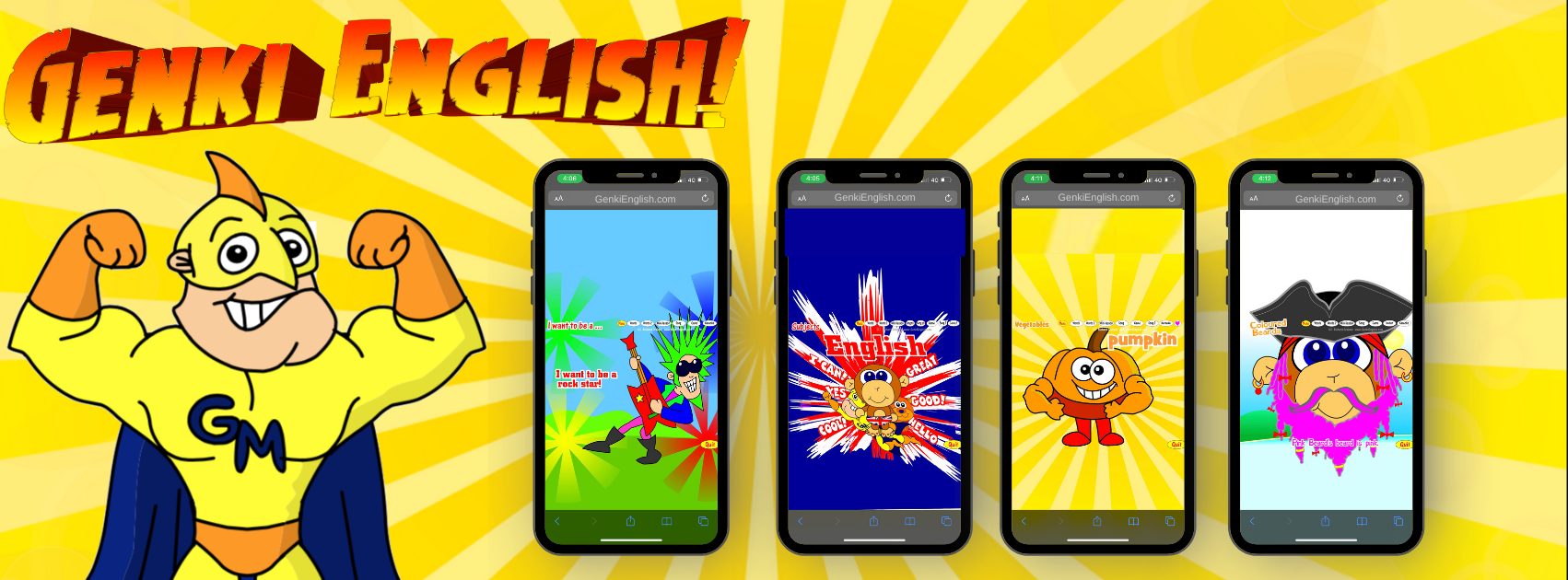Want the fastest (and probably easiest) way to teach reading?
That would be phonics, and hopefully Genki Phonics, of course.
I’ve just uploaded the first part of the Genki Phonics workshop from Slovakia so you can see how I do it.
You’ll find:
- The reason I had to write Genki Phonics, and what’s wrong with the other programs.
- Getting the discipline right so everyone does the gestures and gets the sounds right.
- How to use the gestures (and use them to distinguish between short and long sounds)
- Why start with “s” and not “a”?
- How to teach the blending
Plus I’m sure you’ll find a whole host of other tips and ideas from seeing me do it in video.
(Click here if you’re on email and can’t see the video.)
If you want more there are more videos on the main Genki Phonics page including the teachers in Tanzania showing you all of the Genki Phonics gestures. (The 3rd video on the page.)
And I’ll also be, fingers crossed, going through Genki Phonics in this weekend’s Asia workshop in Kawasaki, and in next month’s Europe workshop in Spain.
Mini Phonics Readers
Lots of teachers have also been asking about extra reading practice.
I have been telling people to get a good “graded reader” course.
But actually the best bet is probably the Phonics Stories we put into the Genki Phonics Posters.
They only use the phonemes learnt so far, so effectively they are a really simple Graded Readers series themselves:



Ninja Tip: I’m also thinking of splitting these out into their own separate download product as they are really too valuable to be included with the regular phonics package. So if you haven’t got them yet, now would be a good time – they’re on the main Phonics Page as part of the Phonics Posters.
If we get enough requests we might also start work back on the other stories for the later phonemes, do let us know if you’d be interested in the comments – I’ll see if we can persuade Margit to start work on them again! 🙂
There you go…
Hope you like the video and of course do ask away if you have any questions!
Happy teaching!
Be genki,
Richard
P.S. Slovak, Czech and Polish teachers…. I’ve got a couple of special surprise presents for you in the VIP forum! 🙂 (We’re going for Ministry of Education accreditation in Slovakia, so I made them up for you – hope you find them useful! ) 🙂




Totally would love some more stories for the later phonemes!
How recent is this video? I thought the Genki Phonics starts with “t”! I know the original was “s” “i” “t”…on the otherhand, either way is better than the Aye a apple, Bee buh banana, etc.
I have a demo coming up for a “Phonics K” class. Yay, phonics. Not yay, the book. The local staff at my school still don’t understand the phonics. All the success with my young classes using Genki Phonics and still they can’t get away from the book and think that what I am teaching has NOTHING to do with the “Phonics K”…well it doesn’t, it is better.
I wish I could get my school to sit down and really learn how to use Genki Phonics and how it is so much better!
It was this summer, we put it back to “s” first, we just couldn’t beat the superhero for the first lesson!! 🙂
Hmmm…I like getting to that first word in the first lesson…The workbooks are still “t” right now, though, as are the posters…or have you switched them around on the website. Guess it isn’t really a major change. I’ll just stick with what I have going, haha. Just found it a little strange that this recent video was using the “old” pattern.
Hi Martin, the VIP ones online are all with “s” first – the “t” first ones were only on for a really short time before everyone told me to put it back! 🙂
http://genkienglish.net/phonics.htm
Just had a writing session with Margit this morning (thanks Margit!) hopefully we’ll have the next stories – “igh” and “oa” – ready hopefully quite soon. I tell you what though when we haven’t written these for a while you forget just how much work goes into them!!
Yeah, definitely. I remember trying to come up with some creative stories using just the phonemes taught and I’m just NOT that creative, haha, or have the time.
I’ll check out the new versions. I suppose they are still a little different that the ORIGINALS where it went “s a t p i n” or something. Not a huge deal if you flip “s” and “t” as long as “i” is second because then you still get a couple very useful words by the third letter. “IT” “SIT” “SITS” as opposed to “SAT” and “AT”
Correct, yeah, I just switched round the “a” and the “i” to get the easier words when everyone wanted the “s” back first!
Yeah, it is crazy with the stories as we have the whole creativity of the first idea, then getting the rhyming and flow, then making sure the kids love the story (and can do imagination activities with it!) plus making it understandable for non-native speaker kids and finally the technical side of making sure there are no phoneme/grapheme we haven’t done yet!
P.S. Thanks again for the “this” funky word pick up before, we’ll get that included in the next revision – it was indeed a mistake on my part! 🙂
I’ve noticed a few other words that could be deemed funky…like “was” in the W lesson. But nothing we couldn’t fudge a little during the class. “This” really stuck out as a decodable word with a sound that hadn’t been addressed at that point. 😉
They look really good! Would love to see more.
I agree, Martin, it would be good if they were used more in schools.
Thank you,thank you,thank you, Richard!I’m a fan of Genki Phonics. I’m going to teach them very soon and need more help. For example,how to teach in-between small stories? Is it neccesary for learners to understand the content? Should they read them at the same lesson they learn the phonics? Do you get them learn the stories by heart? Do you ask questions on them?
Thanks everyone for the great comments!
@Elvira:
For example,how to teach in-between small stories?
Do the 5 minute phonics lessons as usual (as per the videos) and then add in the story between two of the regular phonics lessons if you have time. It usually takes 5 minutes to read two lines of a story so you don’t have to do them all, there’s flexibility there to do as little or as much as you make time for.
Is it necessary for learners to understand the content?
No. The stories are all designed to be comprehensible but in reality with just 5 or 10 minutes per lesson every class splits into two, with half the kids getting the meanings and the half the kids not. Don’t worry too much about this and just see them as pure phonics reading practice for those kids. The main thing at first is to teach fluency of the mechanical reading skill, the comprehension we can come back and focus on later.
Should they read them at the same lesson they learn the phonics?
Usually yes. They should never read the stories *before* they’ve done the associated phonics lesson, but you can also keep them for later if you wish. Some teachers do do this and save them for review sessions later on in the course!
Do you get them learn the stories by heart?
No, no, no, no, no! 🙂 Learning by heart has no relation on the reading skill. It is a shame because we put so much craft into the stories that they would actually make wonderful plays or even audio stories. But there are other options for these types of things, whereas there are very few good options for reading practice, so that’s what we stick to here. (Although you could of course use them as stories, plays etc. much, much later on when the kids are fluent readers and you are teaching things like dramatic intonations etc. But keep that for way after they’ve mastered the phonics!)
Do you ask questions on them?
A little, but not too much. Things like pointing to the rat picture and asking “Is this Ron?” are really great as most of the kids (or even adults) will just say “Yes!” Then you say “Really?” and slowly but surely you’ll see some kids break into a big, silent, smile as they figure it out! It’s really fun seeing every eventually get it!
But don’t turn them into those really boring “reading comprehension” tasks that some exams ask for! 🙂 Unless you have a really bright class of course!
Hope that helps, let me know if you have more questions!
Great explanation of the course. Good to get some clarification about the stories. We try to read the stories together as a class just to expose them to the reading process and the sight words. The class definitely does split into two groups (though this happens for the basic reading part, too, not just comprehension, and I need to work on that).
I had a duh moment during your explanation. Duh, of course, I can go back and have the kids read the stories again later for review and then dive a little more into comprehension when their reading has improved AND they’ve learned more English along the way.
I’ve also been worried that I’m moving too fast through the phonics or at least making them do too much during the class (the new letter AND the story)…and I was doing this because I wanted to get through AT LEAST the 26 basic sounds and stories and I only have 39 or so lessons to do so. I was thinking that if in the future I’m still at this school, I could start the phonics a level earlier and then would have space of 80 lessons to only cover one page each lesson…but now I see that it is fine to do the story the same lesson. (If I ever have to teach a class doing the level previous Y3, then I will start the phonics then to prevent a repeat of the Aye aaa alphabet teaching in the actual course and then I can teach even more phonics and more reading when they get to Y4. The big problem is that the kids often quit or move to other classes or jump to “primary” level classes whenever we get to the end of a level (no matter WHERE they are within the overall course).
Getting a little off-topic, I have a few students that are doing this pretty soon. Luckily, they will be jumping up to my “primary” level course (Phonics K) where I will be trying to teach Genki Phonics rather than the EXTREMELY SLOW AND SIMPLE 26 letter recognition course Aye a, Bee buh, style. I find it strange that these kids are jumping from the young kids course where the letters are taught Aye a, Bee buh, to a “primary” level course which is basically the same thing except only once a week and no English taught in addition to the “phonics”. When the Chinese staff ask for my opinion on whether a kid is ready to jump to the “primary” class, I suggest they just stay in my young class where we are actually learning phonics and English rather than the “primary” course they SAY is more advanced and teaches these things.
I’m really happy to hear, teachers are using the stories.
This is motivational to work on more.
It IS difficult, but I’ve always been into poems and “rules” of writing, and find it easier to write something the more limited I am, so hopefully we can get this through the end, and maybe even can come up with 2 stories or so, for a few phonemes.
@Elvira,
as for “asking questions” or “comprehension, one thing you can do, that is real fun is,
after they have sounded out the story once,(or twice)
have them close their eyes and imagine the story while you read it; then, in between you stop and ask:
“What color is your cat?” “Is your dog big or little” etc, so they don’T just sleep away.
This gives them also the material to draw their story at home.
But as Richard says:
“comprehension” is not the first aim! But reading. I do this activity with the more simple stories, the once you can also TPR or having a lot of action.